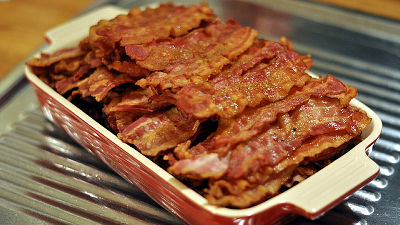Does eating burnt food really cause cancer?

The `` burnt '' that occurs when baking bread or meat can occur accidentally due to a cooking mistake, or it can be caused by intentionally burning the food to add a fragrant flavor. Inverse, a scientific media, explains the theory that ``burnt food contains carcinogenic substances.''
Can burnt toast cause cancer? A doctor explains the complicated science
The `` scorch '' that occurs when baking bread or meat occurs when amino compounds and sugars undergo a complex chemical reaction called the Maillard reaction due to heat, resulting in the production of brown substances and aromatic components. If it is too burnt, it will taste too bitter and be difficult to eat, but many people prefer the aroma of just the right amount of browning, and some rice cookers have a function that intentionally burns the rice. There is also.
However, some of the chemicals produced by the Maillard reaction may have harmful effects on the human body, such as acrylamide , heterocyclic amines (heterocyclic amines/HCAs), and polycyclic aromatic hydrocarbons (PAHs). There are some things that exist.
HCAs and PAHs commonly occur during the cooking of meat, and are produced by the combination of proteins, sugars, and fats, or by smoke from meat juices falling on the charcoal. Acrylamide, on the other hand, is found in everything from roasted coffee to french fries and cigarette smoke. When these three chemicals are taken into the body, they can destroy the DNA of cells and cause dangerous mutations, which is why burnt food contains carcinogenic substances. This is the reason why In fact, in 2017, the UK Food Standards Agency launched the ` `Go for Gold'' campaign to discourage over-burning of toast and potatoes by recommending that toast and potatoes should be burnt to a golden brown rather than black.

But determining whether burnt food really increases cancer risk is more difficult and complex than it seems, says
Indeed, HCAs and PAHs have been shown to be involved in the development of cancer in animal studies including monkeys, and acrylamide has been confirmed to be carcinogenic in animal studies using rodents. However, it is logistically and ethically difficult to confirm these results in human clinical trials, so ``although it contributes to cancer development in animals, we cannot say anything definitive about it in humans.'' That seems to be the reality.
Sinha said, ``The main studies [on charring and carcinogens in humans] ask healthy subjects about how they prepare their food and follow them up 10, 15, 20 years. 'We're going to go and compare people who have had cancer with people who haven't, and see if there's any relationship with the way food is prepared.' In other words, the study is merely an investigation into the relationship between cooking methods and cancer, and is not intended to prove that ``a specific substance causes cancer.''
Of course, the unethical idea of ``splitting healthy subjects into two groups and feeding one group with food full of charred food suspected of containing carcinogens, and giving the other food with no charred food.'' Since research cannot be conducted, at most research can only show a correlation between cooking methods and cancer.
Several observational studies have been conducted on acrylamide in humans, but the results seem to be mixed, with some concluding that acrylamide is not involved in cancer at all, and others concluding that it is suspected to be carcinogenic. There are some that are. Similarly, it is difficult to know the standard for ``how much burnt food can I safely eat?'' as it can vary greatly depending on the type of food.

However, although it is currently difficult to provide a clear answer, scientists are proceeding with research into the relationship between the chemicals contained in charred food and carcinogenicity using new approaches. Particularly interesting, says Sinha, is a method that uses biomarkers contained in human blood and urine. By using human body biomarkers, it is possible to accurately measure the amount of acrylamide, HCAs, and PAHs ingested by a subject, and it is expected that the relationship between chemical substances and cancer can be more accurately determined.
Although Sinha said it was still not possible to say for certain whether charring or carcinogenicity was possible, he said avoiding cooking meat, vegetables and bread over extremely high heat can help avoid the potential risks. He recommended using sous vide methods to lock in flavor and being careful not to darken the food too much.
Related Posts:







